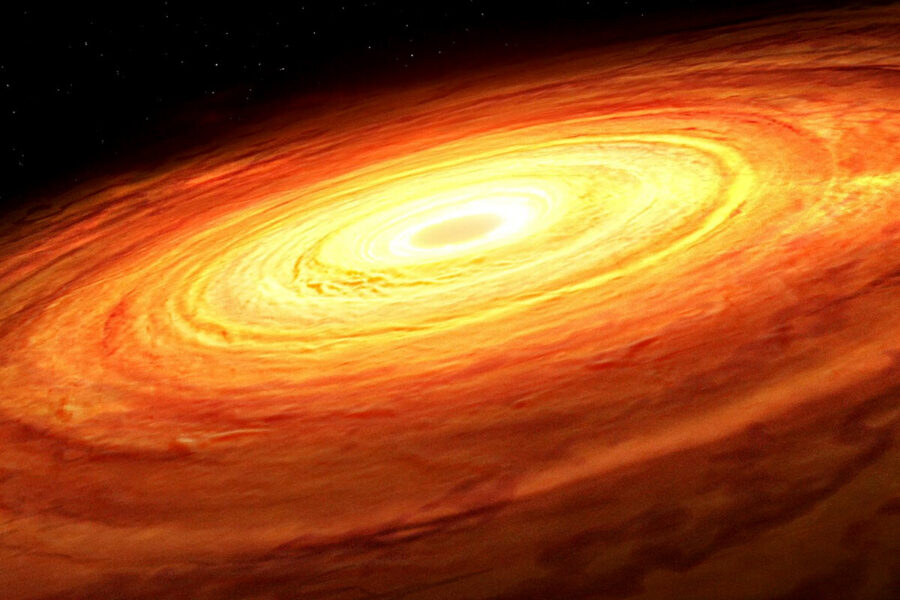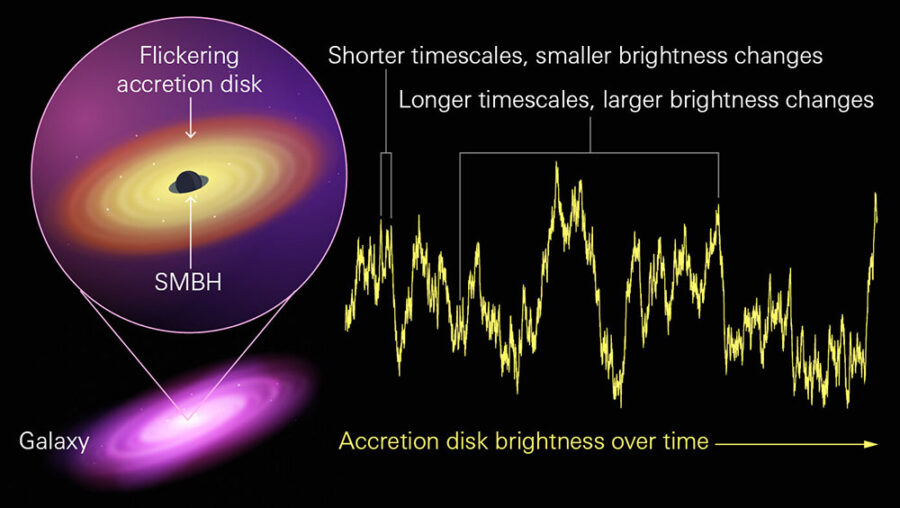Astronomers are using quasars’ extreme variability to determine the masses of the black holes that power them.

Mark A. Garlick / Simons Foundation
No one knows why quasars flicker. Yet these wavering beacons of light might be sending us a message about the black hole systems that power them.
Whirling plasma disks feed supermassive black holes in distant galaxies, and these disks produce a cascade of visible and ultraviolet light that can outshine all the stars in the host. With so much energy packed into such a small space, though, the disks become unstable. As a result, their emissions change randomly, brightening and dimming with no recognizable pattern attributable to any single feature, such as, say, a hot spot orbiting around the black hole.
Astronomers are actively working to understand why black hole disks behave the way they do. But even if we don’t fully understand the mechanism behind the flickering, we can still use it to understand the systems themselves, assert Colin Burke and Yue Shen (University of Illinois, Urbana-Champaign) and their colleagues in the August 13th Science.
Mass from Flickers
Mass is one of only two descriptors of black holes (the other being spin) — they are otherwise the ultimate black box. Yet supermassive black holes are difficult to heave onto a scale.
Astronomers can measure the whirling stars or gas in the galactic center to directly “weigh” the central black hole, but this method only works for nearby specimens (most notably our own 4 million-solar-mass behemoth, Sgr A*). Other more indirect mass measures involve timing light coming from the disk as it “echoes” off nearby clouds, or even more indirectly, determining the mass based on relationships with properties of the host galaxy.
Finding a new method to determine black hole mass would be a big win, and previous studies hinted that variability might be the way to do it. So Burke’s team analyzed 67 quasars to determine on what timescales — days, weeks, months, or years — their random brightness changes become noticeably smaller.

Lucy Reading-Ikkanda / Simons Foundation
The researchers then compared that damping timescale to the black holes’ previously measured masses (using one of those other means mentioned above).
Lo and behold, they found that the damping timescale predicts the black hole mass over a huge scale, from 10,000 to 10 billion solar masses. The improved data, especially the wide range in mass, enabled the team to make clear a relation that previous studies had only hinted at.
It’s not a perfect 1:1 correlation, though; individual predictions are still uncertain by a factor of two. It could be that different black hole spins or feeding rates throw the relation off a bit, or perhaps the black hole masses themselves are not exactly right. But overall, the relation is as good as any other that astronomers currently use to obtain black hole mass.
This method has a downside, though, and that is time. The team needed years of brightness data for each quasar in their sample. What’s more, the farther a black hole is, the more its signals are stretched out in time. More massive black holes also have longer damping timescales, and the distant black holes we see tend to be more massive.
While Burke and Shen’s team pored through previously published data for their sample, in the future data on more distant quasars could come from large all-sky surveys, such as the one astronomers intend to conduct with the Rubin Observatory when it comes online next year.
Why Do Quasars Flicker?
The relation with damping timescale may have given astronomers a new way to measure mass. But it also gives them a new way to understand variability.
“One of the most interesting aspects of the study of Burke et al. is that it extends its findings to much less massive objects, such as white dwarf stars,” Paulina Lira (University of Chile) and Patricia Arevalo (University of Valparaiso, Chile) write in an accompanying perspective piece. “That the same relation extends through many orders of magnitude suggests that the physics of accretion disks is, at least in some aspects, scalable.”
What a flickering black hole accretion disk actually looks like remains consigned to artist’s interpretations. Is the entire disk crackling with magnetic fields, or do hotspots flare up and dissipate in the denser inner regions?
Shen suggests that the damping timescale his team measured is actually the thermal timescale, or how long it takes for the disk to cool off after something has riled it up. Instabilities in the spiraling plasma are constantly agitating the disk, but any individual temperature flare only lasts on the order of 100 days. Whatever is causing the variability, it’s intrinsic to the seething plasma in the hottest and densest part of the disk.
Without the ability to resolve an image of these disks, astronomers will continue to use different wavelengths and arrival times of quasar light to better understand these black hole–powered systems.
 0
0









Comments
You must be logged in to post a comment.